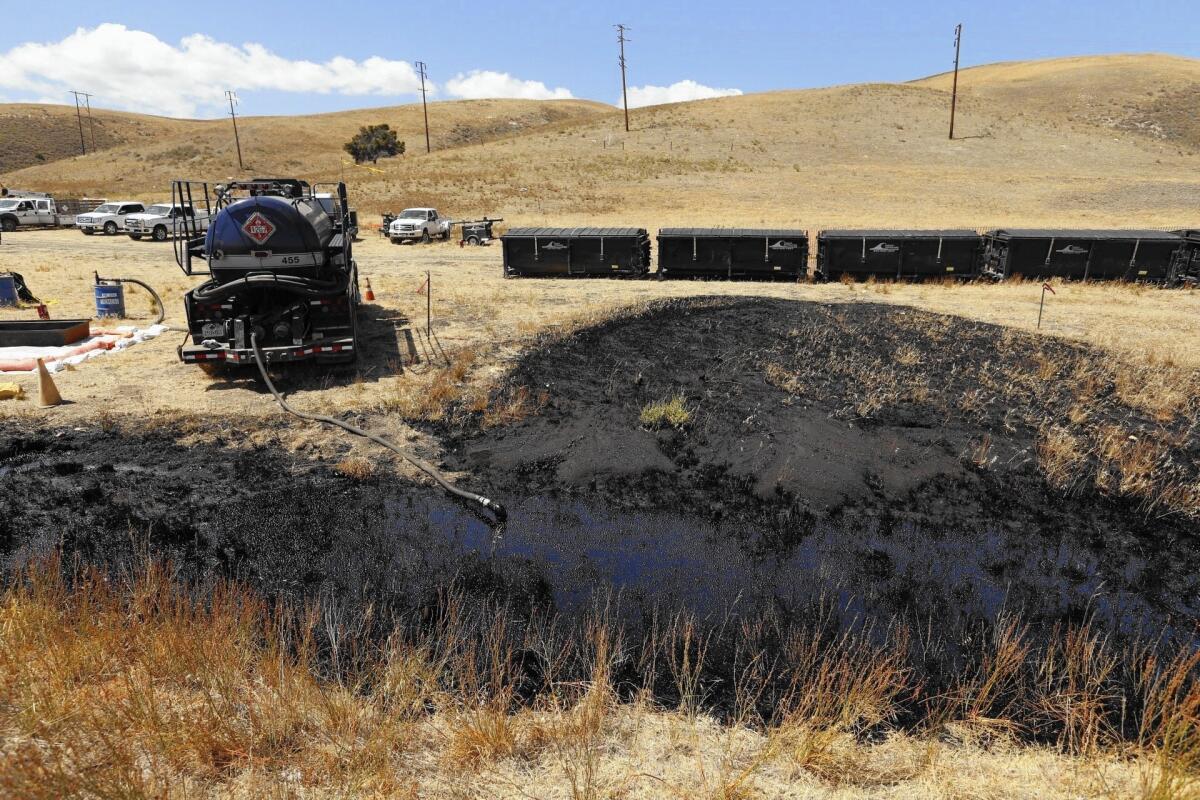Oil spill cleanup accelerates on Santa Barbara County coast

The oil pipeline rupture at Refugio State Beach may have spilled as much as 105,000 gallons of crude, authorities said.
- Share via
reporting from Refugio State Beach, Calif. — Crews are working around the clock to clean up the site of an oil spill in Santa Barbara County that has sent tens of thousands of crude into the Pacific Ocean and left even more saturating the soil.
Michelle Rogow, an on-scene coordinator for the U.S. Environmental Protection Agency, said the effort -- including skimming oil off the ocean’s surface and bagging oily sand from Refugio State Beach -- is a 24/7 operation.
“Today, we’re working with Caltrans on road closures so that work can continue throughout the day on the area of the culvert that passes underneath the highway,” she said.
The oil spill occurred Tuesday when a 24-inch wide pipe owned by Plains All American Pipeline installed in 1987 under Highway 1 ruptured, pouring up to 105,000 gallons of crude into a culvert, with an estimated 21,000 gallons making its way into the Pacific Ocean.
The oil has coated at least five pelicans, rimmed the beach in black goo and created slicks that span nine miles of coastline.
On Thursday, Plains officials said they were accelerating the cleanup effort with 18 vessels working to skim the ocean surface and soak up the crude with booms. More than 8,300 gallons of oily water have been collected, officials said.
During the work, air quality is being monitored for hydrogen sulfide and other volatile compounds, EPA officials said.
Plains All American Pipeline, based in Texas, has accumulated 175 safety and maintenance infractions since 2006, according to federal records.
A Times analysis of data from the Pipeline and Hazardous Materials Safety Administration shows Plains’ rate of incidents per mile of pipe is more than three times the national average.
Among more than 1,700 pipeline operators listed in a database maintained by the federal agency, only four companies reported more infractions than Plains Pipeline.
Company representative Patrick Hodgins said Plains was “committed to doing the right thing.”
“We’re not going away,” he said Thursday in a news conference. “We’re going to be here until it’s returned back to the way it was.”
Capt. Jennifer Williams of the U.S. Coast Guard said officials needed to manage the public’s expectations.
“Cleanup doesn’t happen overnight,” she said. “It’s a moving target when you’re talking about oil on the water. It’s a very difficult process.”
The toll of the spill, however, has begun to show in the local marine life.
About 100 feet from where the rupture occurred, a sea lion raised its oil-covered head to the sky and collapsed on the beach. It rested its head on a rock and rolled onto its back, exposing a shiny, oil-stained belly.
UC Santa Barbara marine sciences doctoral student Anna James stopped collecting water samples and looked over at the struggling animal.
“That poor sea lion really puts it all into perspective,” she said.
Sea lions normally run off when humans are near, she said. The sea lion was too tired to move.
The sea lion, which appeared to be female, allowed in the sand just below a rocky cliffside covered almost entirely in black oil.
Marine mammals and fish are turning up on shore both dead and alive. A pair of cleanup workers in protective suits walked up the beach with nets and boxes. They were ready to capture and clean birds, not sea lions.
California Department of Fish and Wildlife Environmental scientist Colleen Young stopped several yards short of the sea lion and scribbled down notes.
She said they would have to wait for a special team trained to deal with sea lions. Just then, the sea lion rose up on its oil-stained flippers and began shuffling to the water. It went into the surf and disappeared into the water.
Young said that even though it was not good for the sea lion to be back in the polluted water, it does not necessarily spell disaster for the animal.
The sea lion’s blubber will protect it and provide warmth, she said, unlike a sea otter that can suffer with oil in its fur.
“Sea lions can cope with it quite a bit better than sea otters,” she said.
Fish and Wildlife Capt. Mark Crossland said 15 trained scientists are out on land and sea looking for oil-injured animals.
Many members of the public looking to help clean up animals have been turned away by officials who say only trained scientists are equipped for the job.
Times staff writers Joseph Serna and Julie Cart contributed to this story.
For breaking California news, follow @montemorin and @jpanzar.
More to Read
Sign up for Essential California
The most important California stories and recommendations in your inbox every morning.
You may occasionally receive promotional content from the Los Angeles Times.












